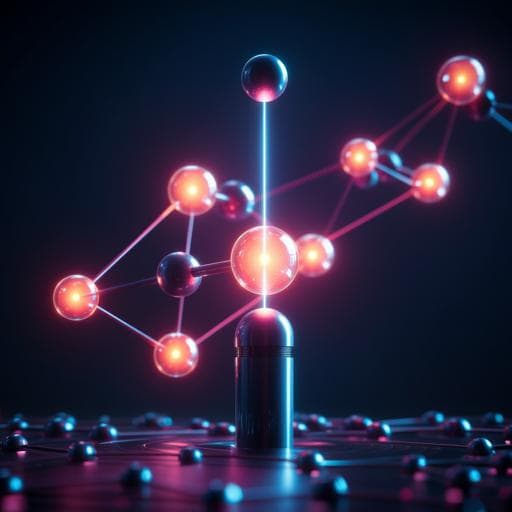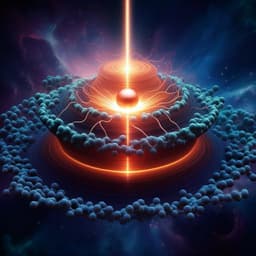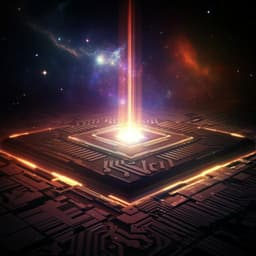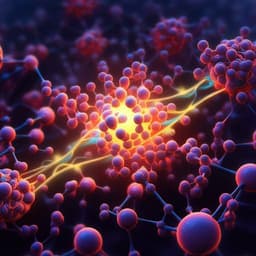
Physics
Multipartite entanglement of billions of motional atoms heralded by single photon
H. Li, J. Dou, et al.
This groundbreaking research by Hang Li, Jian-Peng Dou, Xiao-Ling Pang, Chao-Ni Zhang, Zeng-Quan Yan, Tian-Huai Yang, Jun Gao, Jia-Ming Li, and Xian-Min Jin showcases the creation and certification of multipartite entanglement among billions of motional atoms in a room-temperature quantum memory, revealing significant insights into ambient condition entanglement and decoherence effects.
~3 min • Beginner • English
Introduction
The study targets whether genuine multipartite entanglement can exist and be directly observed in macroscopic, room-temperature systems with motional atoms, despite decoherence from thermal motion and environmental coupling. Large-scale multipartite entanglement underpins advantages in quantum communication, simulation, computation, and metrology, with Hilbert space dimension growing exponentially with particle number. Prior demonstrations of multipartite entanglement (e.g., GHZ, twin-Fock, W states) have generally required cryogenic or highly isolated conditions due to fragility under decoherence. The work proposes using a far-off-resonance Duan–Lukin–Cirac–Zoller (DLCZ) spontaneous Raman scattering protocol in a hot cesium vapor to herald and verify a W state shared among billions of atoms. The purpose is to both certify genuine multipartite entanglement at ambient conditions and to observe its dynamical evolution (entanglement depth) under decoherence within a quantum-memory-built-in configuration.
Literature Review
Previous experimental progress includes GHZ states up to 12 qubits in superconductors, 18 qubits in photonics, and 20 qubits in trapped ions, though scaling is limited by exponentially suppressed multi-particle detection efficiency. Twin-Fock entanglement in BECs has been achieved via quantum phase transitions. W states, requiring detection of a single shared excitation, are more scalable and have been realized at large scales in atomic ensembles. However, these achievements relied on ultralow temperatures and strong isolation to mitigate decoherence from motion and collisions. For room-temperature platforms, EIT and near-resonant Raman schemes in hot vapor suffer from fluorescence noise and limited bandwidth. A far-off-resonance DLCZ protocol was shown to suppress collision-induced fluorescence and enable broadband operation suitable for room-temperature memories, motivating exploration of ambient-condition multipartite entanglement.
Methodology
System and protocol: A warm 133Cs vapor cell implements a far-off-resonance DLCZ scheme in a Λ-type three-level system (|g> = 6S1/2, F=3; |s> = 6S1/2, F=4; |e> = 6P3/2, F=2,3,4,5). Short (≈2 ns) pump and probe pulses are used. The pump (control) induces spontaneous Raman scattering (SRS) generating a correlated Stokes photon and a collective spin-wave excitation. In the weak-excitation regime, a heralded single Stokes detection prepares an atomic W state with one shared excitation distributed over N motional atoms. High-order excitations are suppressed by operating with small excitation probability but are accounted for in certification.
Optical layout and filtering: Pump and probe are collinear and horizontally polarized; Stokes and anti-Stokes photons are vertically polarized and separated by high-performance Fabry–Pérot cavity filters into distinct detection channels. The MASTER–SLAVE laser system is frequency-stabilized to the |6S1/2, F=4>↔|6P3/2, F=4> transition to ensure spectral alignment and filtering performance. Detuning is set to Δ ≈ 4 GHz (far larger than Doppler broadening) to suppress fluorescence noise and yield high cross-correlation.
Timing: Each experimental cycle consists of atomic state preparation with a pump beam (≈700 ns), then generation (2 ns pump off; excitation pulse) and verification (2 ns probe pulse) with a programmable delay (tested 30, 120, 300, 450, 900, 1200 ns). The broadband configuration enables high repetition rate.
Witness and observables: Certification uses an M-separability entanglement witness compatible with photon-number statistics, particularly effective when the vacuum component dominates. The key observables are: (i) p1, the conditional probability to retrieve an anti-Stokes photon given a heralding Stokes; (ii) p2, the probability of two-excitation events inferred from the anti-Stokes autocorrelation g^(2)AS,AS via a Hanbury Brown–Twiss (HBT) interferometer. For fixed M, the theoretical minimal p2 as a function of p1, pbound(p1, M), is derived (symmetric solution via Lagrange multipliers) to bound separable structures. Experimental tr(ρW) < 0 (data falling below the M-curve) implies entanglement depth D ≥ N/M. Data are reported as raw and loss-corrected; detection and channel losses are independently calibrated and subtracted so that p1 and p2 reflect the state at the conversion moment.
Data acquisition and processing: Single-photon detections (Stokes, and anti-Stokes split on a 50:50 fiber beam splitter) are time-tagged. p1 = NS−AS/(NS + NAS) and p2 = 2 NS−AS1−AS2 / NS after correcting for detector efficiencies (typical anti-Stokes detection losses ≈1.85–1.95%). Cross-correlation g^(2)S,AS and anti-Stokes autocorrelation g^(2)AS,AS quantify quantum correlations and multi-excitation noise. The dependence of p1, g^(2), and the inferred M on storage time is measured to characterize decoherence.
Ensemble size estimation: Atomic number density n is obtained by fitting the probe transmission spectrum with a Voigt-profile absorption model, yielding n ≈ 1.21×10^18 m−3. The effective coherent interaction volume is evaluated using Gaussian beam parameters (waist W0 ≈ 100 μm, Rayleigh length z ≈ 3.69×10−2 m) and phase-matching constraints set by the fiber collection angle and SRS angular distribution, ensuring the Gaussian beam-limited mode is within the coherence bound. The resulting number of atoms participating in the entangled mode is N ≈ 8.85×10^9.
Control parameters: The main tunable parameter is pulse energy (tested ≈115.5 pJ, 225 pJ, 330 pJ) which sets the Stokes excitation probability. A beam waist of ≈100 μm balances excitation rate and coherence; far-detuned operation (Δ ≈ 4 GHz) minimizes unconditional noise.
Key Findings
- Genuine multipartite entanglement among a macroscopic, room-temperature atomic ensemble was certified using an M-separability witness based on correlated photon statistics.
- At short storage times, the entanglement depth is at the billion-particle scale. Using N ≈ 8.85×10^9 atoms and measured (loss-corrected) statistics at 30 ns, the entanglement depth is at least 1.77×10^9 atoms (M ≈ 5). Raw at 30 ns: p1 = 0.0123, p2 = 2.49×10^−5; loss-corrected: p1 ≈ 0.32, p2 ≈ 0.017.
- Dynamic evolution with storage time (30–1200 ns) shows increasing M (more separable subgroups) due to decoherence from thermal motion; representative M values: 5, 6, 10, 14, 92, 1000 for 30, 120, 300, 450, 900, 1200 ns, respectively. With error bars, upper bounds [5, 6, 12, 16, 130, +∞] and lower bounds [5, 5, 9, 13, 90, 323].
- Entanglement depth versus storage time (loss-corrected) decreases as: [1.77, 1.47, 0.88, 0.63, 0.09, 0.009] × 10^9 for 30, 120, 300, 450, 900, 1200 ns; lower bounds: [1.77, 1.47, 0.74, 0.55, 0.07, 0] × 10^9. With 3σ confidence for 30–900 ns: [1.77, 0.59, 0.35, 0.35, 0.01] × 10^9.
- The retrieval probability p1 decays approximately exponentially with delay, indicating decoherence of collective phase and diminishing collective enhancement. Cross-correlation g^(2)S,AS decreases and anti-Stokes autocorrelation approaches 1 with increasing storage time, consistent with reduced entanglement and increased classicality.
- Dependence on excitation probability (pulse energy): Stronger pulses increase p1 and reduce M (implying larger entanglement depth for fixed N) without evidence of dominant noise-induced deterioration in the explored range (≈115.5–330 pJ). Constraints in available laser power limited exploration of the full trade-off; expected decrease in g^(2)S,AS at higher energies suggests a turning point where noise would reduce depth.
Discussion
The results address the central question by verifying genuine multipartite entanglement among billions of motional atoms at room temperature, demonstrating that macroscopic entanglement can persist and be directly probed in ambient conditions. The quantum-memory-built-in, heralded approach enables time-resolved observation of entanglement depth, revealing the impact of thermal-motion-induced decoherence as the entangled ensemble evolves into multiple separable subgroups. The observed decay in p1, cross-correlation, and increase in M quantitatively map the quantum-to-classical transition. The verified billion-scale entanglement depth substantially extends the accessible scale of entanglement beyond cryogenic or isolated platforms, indicating feasibility for practical quantum technologies. The witness framework, compatible with dominant vacuum components, provides a scalable certification tool for such macroscopic systems.
Conclusion
The study experimentally demonstrates and certifies genuine multipartite W-state entanglement among billions of motional atoms in a room-temperature cesium vapor memory, using a far-off-resonance DLCZ protocol and a photon-statistics-based M-separability witness. The approach permits direct observation of the dynamical evolution of entanglement depth under decoherence. This expands the boundary of large-scale entanglement operation in practical, ambient environments and suggests new avenues for real-world quantum technologies. Future directions include increasing the entangled particle number (e.g., larger beam waists, stronger pulses with controlled noise), extending coherence times via anti-relaxation coatings and by transferring collective excitations to long-lived noble-gas nuclear spins, and leveraging the robustness and collective enhancement of W states for quantum sensing and multiparameter quantum metrology.
Limitations
- Decoherence from thermal motion rapidly reduces entanglement depth with storage time, approaching classical bounds at long delays (≈1200 ns).
- Higher-order excitations, while suppressed, still contribute and can alter entanglement structure; certification relies on statistical bounds and assumes at most two excitations dominate.
- Detection and channel losses require calibration and correction; while accounted for, they add uncertainty to p1 and p2 estimates.
- Limited available laser power constrained exploration of the full trade-off between excitation probability, noise, and entanglement depth (e.g., could not probe potential turning points at higher pulse energies).
- The witness provides lower bounds on depth; true entanglement size may be larger but is not directly measured.
Related Publications
Explore these studies to deepen your understanding of the subject.







